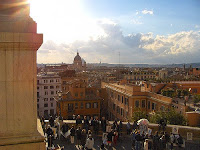Of Mysteries and Mushrooms
Our key destination today was the convent associated with the Chiesa di Trinità di Monti, which occupies a magnificent vantage point at the top of the Spanish Steps.
After Friday’s mix up with meeting places I was determined:
A. To be on time
B. To be in the right place at the right time.
Not willing to risk getting stuck in a traffic mishap or getting lost on the busses I EVEN took the underground to the Spagna stop. Thus, I was more than a half an hour early. I bought a newspaper and sat on a bench, watching a tidal wave of people, not unlike the earlier tsunami that had been emerging from Ottaviano on their way to see the Pope. This flood, washing out of the underground, carrying rolled up flags and banners, were on their way to Day 2 of the manifestazione against Berlusconi’s cuts in the education budget.
After about 20 minutes with no sign of N. it occurred to me that maybe I was in the wrong place - again, as she had mentioned something about taking the lift to the top of the stairs. ‘OK, let’s try it. It’s free; I can always come back down if I don’t see her there.’
HOWEVER!!! When I emerged onto the white marble balcony over looking Roma, there standing on the steps leading up to the Chiesa, was my N., accompanied by a attractive full size cynical teddy bear. This turned out to be, at long last, the incomparable Cesare. The tour of the C
 onvent was not scheduled to start until eleven so we stood looking over a beautiful blue-skyed Roma, trying to identify landmarks. ‘Lemme tell ya, it’s not easy. From that height and distance, all church tops look more or less the same.’
onvent was not scheduled to start until eleven so we stood looking over a beautiful blue-skyed Roma, trying to identify landmarks. ‘Lemme tell ya, it’s not easy. From that height and distance, all church tops look more or less the same.’We were finally allowed into an anti-room to await the start of the tour. The youngish nun who guided us spoke: French, very softly, and looked down at the ground the whole time. I did glean that the convent was started by the French King Louis XII in 1502 which explained the rather a
 mazing series of frescoes around the inside of the arcade. Starting with Clovis or Pepin, images of ALL the French monarchs had been inscribed on opposing pairs around the ceiling of the cloister.
mazing series of frescoes around the inside of the arcade. Starting with Clovis or Pepin, images of ALL the French monarchs had been inscribed on opposing pairs around the ceiling of the cloister.The tour needs to be booked in advance and lasts over an hour. It’s worth it. We saw many, many interesting things. For me, three images stood out:

An Astronomical Map, painted in 1637 which calculates the positions of all then known places using the measurements based on the movements of the stars and the constellations.

The trompe-l'œil dining room where the brothers were expected to eat in silence watched over by murals of life-like riotous carryings-on. That kind of dichotomy would have driven me insane.
And finally, I couldn’t take my eyes off of an American (had to be) woman wannabee Jane Fonda, who should seriously consider a career as an actress impersonator.
After the tour, emerging into bright sunshine, we descended the Spanish Steps into crowds of Saturday Romans and tourists. We strolled past the newly unveiled and controversial enclosure by Richard Meyer protecting the Ara Pacis, one of the artistically most important
 monuments of ancient Rome. We continued strolling, talking and strolling until we reached Gran Caffè Esperia, Lungotevere dei Mellini, an elegant deco-style café – where it was decided that an aperitivo was needed. I drank a ‘bitter rosso’, not unlike Campari, which came with a plate of warm mini-pizzas. YUMMY!!!
monuments of ancient Rome. We continued strolling, talking and strolling until we reached Gran Caffè Esperia, Lungotevere dei Mellini, an elegant deco-style café – where it was decided that an aperitivo was needed. I drank a ‘bitter rosso’, not unlike Campari, which came with a plate of warm mini-pizzas. YUMMY!!!After finishing our drinks we continued our perambulations towards Campo de’ Fiori and one of N’s favourite restaurants, Trattoria da Francesco on the Piazza del Fico. There I had the second gustatory triumph of my visit - white pizza with fresh porcini, nothing m
 ore (HUH!) than fresh sliced mushrooms, cheese and olive oil – how can food this simple taste so good? I also had carciofi – lot’s more carciofi, and zucchini and olives and ……ahhhh… for antipasti.
ore (HUH!) than fresh sliced mushrooms, cheese and olive oil – how can food this simple taste so good? I also had carciofi – lot’s more carciofi, and zucchini and olives and ……ahhhh… for antipasti.C. had trippa. He cleaned his plate so thoroughly, relishing every bite, that I vowed to myself - someday I’m going to find the courage to try THAT.

By now it was three-ish, so time for a gelato, from a shop just beside the Pantheon that N. & C. swear has the best gelatti in Roma. After vanquishing our cups of lemon, fruits of the forest and chocolate sitting on a wall beside the Pantheon, I believe them.
Then as all good things end sooner than bad, it was time to say good by.
Thanks to N. I’d had an amazing week – packed with event, adventure and amazing food.
Tomorrow I take the train for Milano.
As before all photographs are by the kind permission of N.





































